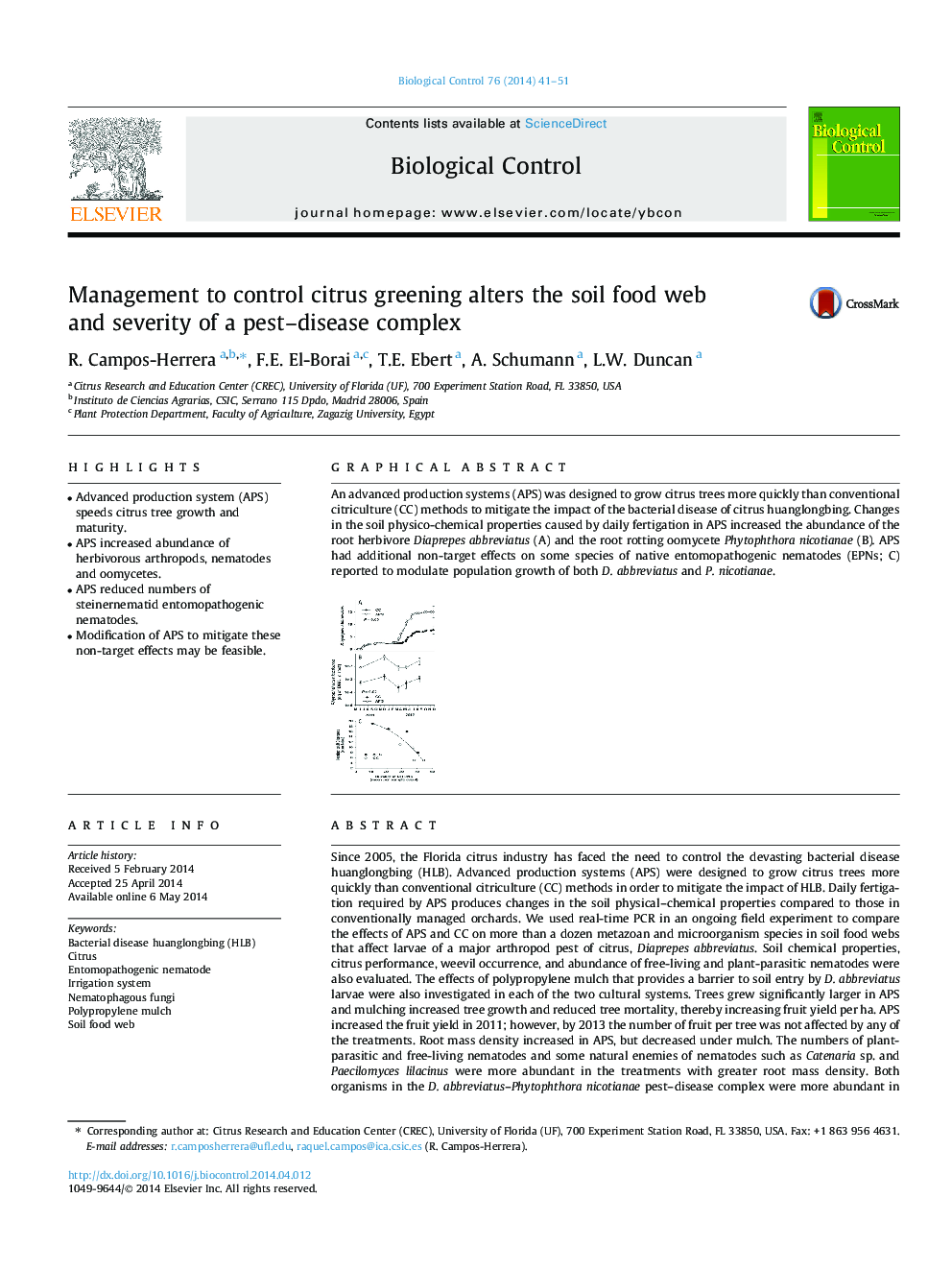| کد مقاله | کد نشریه | سال انتشار | مقاله انگلیسی | نسخه تمام متن |
|---|---|---|---|---|
| 4503882 | 1624258 | 2014 | 11 صفحه PDF | دانلود رایگان |
• Advanced production system (APS) speeds citrus tree growth and maturity.
• APS increased abundance of herbivorous arthropods, nematodes and oomycetes.
• APS reduced numbers of steinernematid entomopathogenic nematodes.
• Modification of APS to mitigate these non-target effects may be feasible.
Since 2005, the Florida citrus industry has faced the need to control the devasting bacterial disease huanglongbing (HLB). Advanced production systems (APS) were designed to grow citrus trees more quickly than conventional citriculture (CC) methods in order to mitigate the impact of HLB. Daily fertigation required by APS produces changes in the soil physical–chemical properties compared to those in conventionally managed orchards. We used real-time PCR in an ongoing field experiment to compare the effects of APS and CC on more than a dozen metazoan and microorganism species in soil food webs that affect larvae of a major arthropod pest of citrus, Diaprepes abbreviatus. Soil chemical properties, citrus performance, weevil occurrence, and abundance of free-living and plant-parasitic nematodes were also evaluated. The effects of polypropylene mulch that provides a barrier to soil entry by D. abbreviatus larvae were also investigated in each of the two cultural systems. Trees grew significantly larger in APS and mulching increased tree growth and reduced tree mortality, thereby increasing fruit yield per ha. APS increased the fruit yield in 2011; however, by 2013 the number of fruit per tree was not affected by any of the treatments. Root mass density increased in APS, but decreased under mulch. The numbers of plant-parasitic and free-living nematodes and some natural enemies of nematodes such as Catenaria sp. and Paecilomyces lilacinus were more abundant in the treatments with greater root mass density. Both organisms in the D.abbreviatus–Phytophthora nicotianae pest–disease complex were more abundant in APS than in CC, whereas fewer steinernematid entomopathogenic nematodes (EPNs) that prey on insect larvae occurred in APS. By contrast, heterorhabditid EPNs tended to be more numerous in APS than in CC, although they comprised <25% of the EPN communities in any treatment. Major differences between APS and CC in almost all of the measured physical and chemical soil properties provide a basis for controlled studies to understand why EPN taxa responded differently to these treatments and how APS and soils generally might be modified to conserve the beneficial activities of nematodes.
An advanced production systems (APS) was designed to grow citrus trees more quickly than conventional citriculture (CC) methods to mitigate the impact of the bacterial disease of citrus huanglongbing. Changes in the soil physico-chemical properties caused by daily fertigation in APS increased the abundance of the root herbivore Diaprepes abbreviatus (A) and the root rotting oomycete Phytophthora nicotianae (B). APS had additional non-target effects on some species of native entomopathogenic nematodes (EPNs; C) reported to modulate population growth of both D. abbreviatus and P. nicotianae.Figure optionsDownload as PowerPoint slide
Journal: Biological Control - Volume 76, September 2014, Pages 41–51
